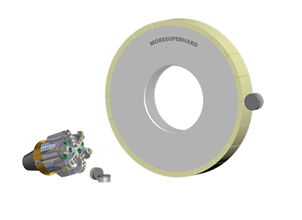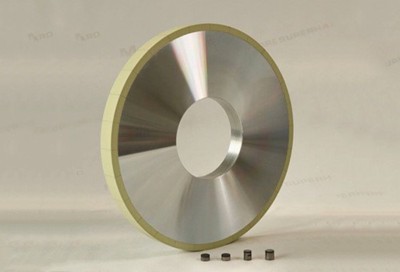The advantages of vitrified bond diamond wheel for grinding PDC

The vitrified bond diamond grinding wheel has the common characteristics of vitrified bond and diamond. Compared with traditional abrasive grinding wheels, it has strong grinding ability, low grinding temperature and high abrasive durability; The shape retention of the grinding wheel is good, and the processed workpieces have high dimensional accuracy; The self-sharpening of the grinding wheel is good, the dressing interval is long, and the dressing is easier; It is not easy to block and burn the workpiece during grinding, and it can be cooled with various coolants. Therefore, the use of vitrified bond diamond grinding wheels is increasing.
Vitrified diamond grinding wheels are mainly used in the grinding and processing of PCD tools, CBN tools, carbide, cermets, ferrites, cast iron, gemstones, traditional ceramics and new engineering ceramic materials, and can also be used for chromium-quenched steel bearing rollers, Precision grinding of crankshafts of automobiles and tractors, gear necks of hydraulic pumps, etc.
PDC is a composite material made of diamond micro-powder and carbide matrix through high temperature and high pressure sintering. Its abrasion ratio generally reaches 130,000 to 400,000, which is an extremely difficult product to process. Compared with the resin bond diamond grinding wheel, the vitrified bond diamond grinding wheel has the following 5 advantages when processing PDC:
1) The grinding efficiency of vitrified grinding wheels is more than 3 times that of resin grinding wheels;
2) During the entire grinding process, the grinding wheel does not need to be dressed except that the surface of the grinding wheel is sharpened first. The resin grinding wheel must be trimmed 7~12 times, otherwise the workpiece cannot be ground;
3) The shape of the ground PDC is also very different. The side projection of the PDC processed by the resin grinding wheel is an isosceles trapezoid, the diamond layer is much larger than the other end of the substrate, and the PDC processed by the ceramic grinding wheel is projected into a rectangular shape. The dimensions of the two end faces are the same, and this point can be clearly measured with a square. Especially when the PDC “runs the material”, the resin grinding wheel can hardly be corrected, and the ceramic grinding wheel will not have this situation. This is mainly because the resin grinding wheel has a certain degree of elasticity and will produce a certain amount of concession during grinding, while the ceramic grinding wheel has a large overall elastic modulus, good rigidity, high temperature resistance, and will not produce a knife phenomenon during grinding;
4) The finish of the workpiece is better than that of the resin grinding wheel. Because the resin material in the resin grinding wheel is not resistant to high temperatures, it is easy to soften at 200 ℃, resulting in greater brittleness, which causes the grinding wheel to collapse, so more copper powder is often added to the grinding wheel to dissipate heat, and the extension of copper It is highly flexible and easy to adhere to the periphery of the PDC, making the processed product not shiny. The products processed by ceramic grinding wheels can almost reach the level of mirror surface, which is expected to be completed in one process of roughing and finishing;
5) Large feed rates can be used. If the resin grinding wheel uses a large feed rate, either the grinding wheel cannot grind the workpiece, or the grinding wheel collapses.
In short, when the ceramic grinding wheel is grinding PDC, its grinding efficiency is high, the number of dressing is less during grinding, the workpiece size is high, and the finish is high. It is the most suitable choice for grinding PDC. However, the problem is that the manufacturing cost of ceramic grinding wheels is higher than that of resin grinding wheels. Therefore, the durability of the grinding wheels must be further improved to expand the cost-effective advantage of ceramic grinding wheels when grinding PDC materials.







